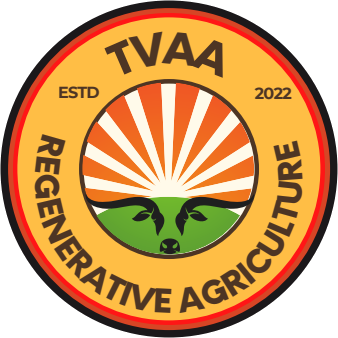Addendum #1
Details of Land Acquisition and Use
Note: There are 2.5 acres in 1 hectare.
Stocking rate — the number of animal units per acre — differs from stocking density. Stocking density takes into account the length of time the animals are in any given area. This assumes that you will be using a well-executed rotational grazing regimen. Rotational-grazing allows animals to graze and fertilize each paddock well. The animals are moved to new grasses before they have the opportunity to over-graze, damaging the roots of the forages in the fields (see page 5 for details).
Following are estimates of infrastructure and animal unit needs on the TVAA Demonstration Farm.
Campus Acreage
3.5 hectares (~8 acres) for school, laboratories, kitchens, childcare nursery, offices, guardhouse, kitchen gardens, laundry, restrooms, solar installations, and wells.Farm Infrastructure
5 hectares (~12 acres) for a variety of barns for animals and poultry, post-harvest storage units, machine shop, slaughter house, and fencing for pastures.Student Farming Plots
Each class of 40 students will need 16.00 hectares (40 acres) on which to work and learn. There will be four (4) simultaneous classes which makes the TVAA need for 64 hectares of student land. Each student, in each class, is apportioned .40 hectares (1 acre) as their farming plot. The need for 160 students x .40 hectare = 64 hectares.Cattle
A rule-of-thumb is that it takes 0.81 hectares (1.5 to 2 acres) per cow-calf pair for 12 months. Ten cows on 8.1 hectares.Hogs
Stocking rate is 10 pigs per 1 hectare (2.5 acres).Sheep
Stocking rate is 10 ewes and 15 lambs per 1 hectare (2.5 acres) of pasture.Goats
Stocking rate six to eight goats on 1 hectare (2.5 acres) of land. Because goats are browsers, not grazers, it is important that the land supplied to them is the type of forage they like to eat.Oxen
Oxen are fueled by grass at the rate of 1 ox per 0.60 hectares (1.5 acres) of pasture which can sustain even the largest breeds of oxen for feeding most of the year. This would provide the potential for many farms to “grow their own fuel.”Turkeys
For every 200 turkeys, a basic rule of thumb is 4.0 hectares (10 acres).Chickens
It is recommended to stock about 50 chickens per 0.40 hectare (1 acre), with a maximum of around 400-500 chickens per 3.6 hectares, as long as they are rotated.
Summary
Campus of 3.5 hectares and farm infrastructure of 5 hectares = 8.5 hectares
Student Plots = 160 hectares
Animal Unit Needs (per table above) = 24.4 hectares
Paddock needs = 90 hectares
Wooded Land = ~15 hectares (needed for making organic compost)
Estimated Total Hectares needed = ~ 298 hectares (Note: For efficiency it would be best to have all of the land contiguous.)
**NOTES: see notes on paddock guidelines below.
Rotational Grazing: Paddock Guidelines
The number of paddocks needed for a rotational grazing system will depend on the number of days the animals graze in a paddock and the maximum summer rest period needed. Rest periods should be based on the growth rate of the pasture, which will vary with the season and weather conditions.
Paddock rest periods for rotational grazing systems.
Since growth rate is affected by soil productivity and fertility levels, even within a pasture system, rest periods will vary. The best way to manage this situation is to have a flexible rotational scheme, moving animals to those paddocks that have reached their optimum available pasture. Animals should be kept off a particular paddock until it reaches its desired optimum available pasture.
Spring management usually involves diverting some of the paddocks out of the rotation scheme and using the forage for hay or silage. This effectively shortens the rest period between grazing and improves utilization of rapid spring growth.
(Maximum days rest divided by number of days grazing) + 1 = paddock number
Example: The herd will graze each paddock for 3 days, and the maximum rest period between grazing will be 35 days.
(35 days rest divided by 3 days grazing) + 1 = 13 paddocks
Species and class of grazing animal may determine the grazing period. Since lactating dairy cows need consistent forage quality, the grazing period for them may be anywhere from five to two days. However, beef cows, brood ewes, and most other ruminants do not need consistent forage quality, so a grazing period of three or more days may suffice.
References: University of Georgia, School of Agriculture, Extension Services, Knight, C. (2018); University of West Virginia, Extension service, Rayburn, E. (2014). Nobel Institute, Ardmore,OK, Aljoe, H. (2018)


